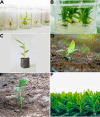Plants in vitro propagation with its applications in food, pharmaceuticals and cosmetic industries; current scenario and future approaches
- PMID: 36311115
- PMCID: PMC9606719
- DOI: 10.3389/fpls.2022.1009395
Plants in vitro propagation with its applications in food, pharmaceuticals and cosmetic industries; current scenario and future approaches
Erratum in
-
Corrigendum: Plants in vitro propagation with its applications in food, pharmaceuticals and cosmetic industries; current scenario and future approaches.Front Plant Sci. 2023 Apr 17;14:1197747. doi: 10.3389/fpls.2023.1197747. eCollection 2023. Front Plant Sci. 2023. PMID: 37139107 Free PMC article.
Abstract
Plant tissue culture technique employed for the identification and isolation of bioactive phytocompounds has numerous industrial applications. It provides potential benefits for different industries which include food, pharmaceutical and cosmetics. Various agronomic crops i.e., cereals, fruits, vegetables, ornamental plants and forest trees are currently being used for in vitro propagation. Plant tissue culture coupled with biotechnological approaches leads towards sustainable agricultural development providing solutions to major food security issues. Plants are the rich source of phytochemicals with medicinal properties rendering them useful for the industrial production of pharmaceuticals and nutraceuticals. Furthermore, there are numerous plant compounds with application in the cosmetics industry. In addition to having moisturizing, anti-ageing, anti-wrinkle effects; plant-derived compounds also possess pharmacological properties such as antiviral, antimicrobial, antifungal, anticancer, antioxidant, anti-inflammatory, and anti-allergy characteristics. The in vitro propagation of industrially significant flora is gaining attention because of its several advantages over conventional plant propagation methods. One of the major advantages of this technique is the quick availability of food throughout the year, irrespective of the growing season, thus opening new opportunities to the producers and farmers. The sterile or endangered flora can also be conserved by plant micro propagation methods. Hence, plant tissue culture is an extremely efficient and cost-effective technique for biosynthetic studies and bio-production, biotransformation, or bioconversion of plant-derived compounds. However, there are certain limitations of in-vitro plant regeneration system including difficulties with continuous operation, product removal, and aseptic conditions. For sustainable industrial applications of in-vitro regenerated plants on a large scale, these constraints need to be addressed in future studies.
Keywords: cosmetics; explants; industry; medicines; pharmaceuticals; plant tissue culture; secondary metabolites.
Copyright © 2022 Hasnain, Naqvi, Ayesha, Khalid, Ellahi, Iqbal, Hassan, Abbas, Adamski, Markowska, Baazeem, Mustafa, Moustafa, Hasan and Abdelhamid.
Conflict of interest statement
The authors declare that the research was conducted in the absence of any commercial or financial relationships that could be construed as a potential conflict of interest.
Figures








References
-
- Afolabi A. S., Oyebanji O., Odusanya O., Abo M. E., Misra M., Ogbadu G. H. (2008). Regeneration of plants from rice caryopsis derived callus culture of Nigerian local cv. suakoko 8 and a NERICA cv. FARO. Afr. J. Plant Sci. 55 (2), 109–112. doi: 10.4103/1596-3519.55666 - DOI
-
- Afrasiab H., Jafar R. (2011). Effect of different media and solidifying agents on callogenesis and plant regeneration from different explants of rice (Oryza sativa l.) varieties super basmati and IRRI-6. Pak. J. Bot. 43 (1), 487–501.
-
- Ahloowalia B. S., Prakash J., Savangikar V. A., Savangikar C. (2003). Plant tissue culture. Low cost options for tissue culture technology in developing countries. Proc. Tech. meeting organized by Joint FAO/IAEA Division Nucl. Techniques Food Agric. held Vienna (Vienna, Austria) pp, 3–10.
-
- Ahluwalia B., Magnusson M. K., Isaksson S., Larsson F., Öhman L. (2016). Effects of Aloe barbadensis Mill. extract (AVH200®) on human blood T cell activity in vitro . J. Ethnopharmacology 179, 301–309. - PubMed
-
- Ahloowalia B. S., Prakash J., Savangikar V. A., Savangikar C. (2004). Plant tissue culture. Low. cost. options. Tissue culture. Technol. developing. countries. 1, 3. doi: 10.1023/B:EUPH.0000014914.85465.4f - DOI
Publication types
LinkOut - more resources
Full Text Sources

